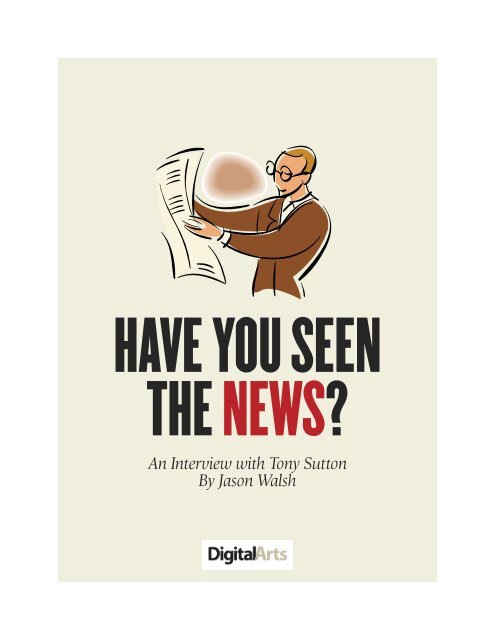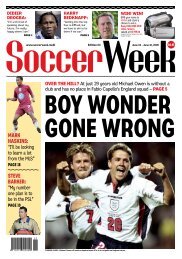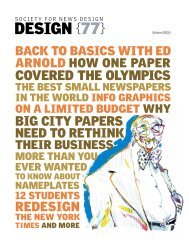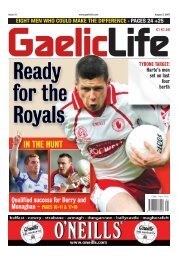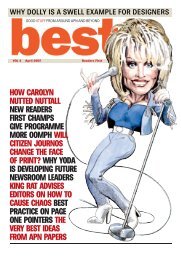An Interview with Tony Sutton By Jason Walsh - News Design ...
An Interview with Tony Sutton By Jason Walsh - News Design ...
An Interview with Tony Sutton By Jason Walsh - News Design ...
Create successful ePaper yourself
Turn your PDF publications into a flip-book with our unique Google optimized e-Paper software.
HAVE YOU SEEN<br />
THE NEWS?<br />
<strong>An</strong> <strong>Interview</strong> <strong>with</strong> <strong>Tony</strong> <strong>Sutton</strong><br />
<strong>By</strong> <strong>Jason</strong> <strong>Walsh</strong>
2<br />
<strong>Tony</strong> <strong>Sutton</strong> is president of <strong>News</strong> <strong>Design</strong> Associates,<br />
Inc. – http://www.newsdesign.net – an international<br />
publishing consultancy based in Georgetown, 20 km<br />
from Toronto in Canada. He is a former editor of the<br />
South African magazine, Drum, and of <strong>Design</strong>,<br />
the magazine of the US-based Society for <strong>News</strong> <strong>Design</strong>.<br />
He is also editor and publisher of the internet magazine<br />
ColdType – http://www.coldtype.net<br />
He may be contacted at tonysutton@newsdesign.net<br />
<strong>Jason</strong> <strong>Walsh</strong> is a former designer turned journalist who<br />
writes about design, culture, politics and technology<br />
and has contributed to a wide range of newspapers and<br />
magazines in the UK, the United States and Ireland. He<br />
studied fine art at the University of Ulster and currently<br />
divides his time between Dublin and Belfast.<br />
This interview appeared in DigitalArts magazine’s<br />
<strong>Design</strong> of The Nation<br />
© <strong>Jason</strong> <strong>Walsh</strong> 2006
HAVE YOU SEEN<br />
THE NEWS?<br />
How often do you think of the<br />
design of a newspaper? Not<br />
very often, I would guess. In<br />
truth, you probably shouldn’t:<br />
A newspaper should be an example of invisible<br />
design, something that’s a lot harder<br />
to do than it sounds.<br />
Of course, in the last couple of years<br />
newspaper design has been far from invisible.<br />
First the Independent came out of the<br />
washing machine a little shorter and a lot<br />
fatter, quickly followed by a newly-tabloid<br />
Times – something Rupert Murdoch later<br />
admitted he’d wanted to do for years.<br />
Both re-formatting exercises brought<br />
about major redesigns, particularly in the<br />
case of the Independent which has received<br />
plaudits for its single-issue front-pages,<br />
though it appears to this journalist at least<br />
in danger of becoming a liberal Daily Mail.<br />
The Times responded by having its features<br />
section, Times2, redesigned by none other<br />
than Neville Brody. Has newspaper design<br />
suddenly become sexy?<br />
Next came the Guardian and Observer<br />
moving to Berliner-size (at almost<br />
exactly the same time, incidentally,<br />
that the Irish <strong>News</strong> moved from<br />
Berliner to tabloid), the Guardian<br />
earning its in-house design<br />
team a <strong>Design</strong>er of the Year<br />
nomination.<br />
<strong>Tony</strong> <strong>Sutton</strong>, head of Cana-<br />
dian-based newspaper consultancy <strong>News</strong><br />
<strong>Design</strong> Associates and former editor of <strong>Design</strong>,<br />
the magazine of the Society for <strong>News</strong><br />
<strong>Design</strong>, should know what’s going on. Lincolnshire-born,<br />
<strong>Sutton</strong> has designed newspapers<br />
and magazines across the globe including<br />
Canada, Australia, New Zealand,<br />
Ireland and South Africa and is an expert in<br />
the field. He answered a few questions on<br />
the subject of news design.<br />
<strong>Jason</strong> <strong>Walsh</strong>: How important is newspaper<br />
design:<br />
- To publishers and readers of<br />
newspapers?<br />
- <strong>An</strong>d to our broader culture?<br />
<strong>Tony</strong> <strong>Sutton</strong>: When I tell people – usually<br />
during inane conversations over rubber<br />
chicken on long, dull, airplane flights – that<br />
I’m a newspaper designer, 99% of them assume<br />
I design the ads. When I put them<br />
right, most are politely incredulous; but<br />
amazed that anyone would pay people to<br />
slap their daily paper together. This indicates<br />
how highly we rate on life’s social<br />
scale: slightly lower than quantity<br />
surveyors. It’s also safe to assume<br />
that the same<br />
proportion of readers is<br />
just as unaware of the<br />
process of newspaper design.<br />
But that’s okay, so long<br />
3
H A V E Y O U S E E N T H E N E W S ?<br />
as we subscribe to the relatively sensible<br />
view that the look of a newspaper should<br />
be subservient to the other stuff – the<br />
words, the pictures and, yes, even the advertising.<br />
After all, our customers buy papers to<br />
read, not to admire. They’re subconsciously<br />
aware of newspaper design, in pretty much<br />
the same way as they’re aware of the design<br />
of crisp packets. But I don’t think it<br />
plays a major part in helping them make<br />
their decision on which daily paper to buy<br />
– I’ve been involved in enough failed<br />
launches to know how entrenched readers<br />
are in their daily buying habits.<br />
Most publishers are aware of the importance<br />
of design, if only because they’ve<br />
spent much of the last 20 years being told<br />
that design is the panacea for plunging circulations.<br />
The fact that sales have continued<br />
to fall suggests that they haven’t always<br />
had their eyes on reality: <strong>News</strong>papers<br />
cease to be relevant for many reasons – design<br />
included – each of which has to be<br />
tackled if declines are to be reversed.<br />
Culturally, newspapers also have a problem,<br />
in that they’re so much yesterday’s<br />
product.They don’t appeal to younger people:<br />
who are more technologically proficient<br />
than their parents, and they, in turn,<br />
are less inclined to read the daily rag than<br />
their parents. I think the average age of<br />
daily paper readers in America is edging 50<br />
– youthful grandparents! So, no matter<br />
how trendy your design or how cool<br />
your colour palette, it’s increasingly<br />
hard to compete <strong>with</strong><br />
iPods, blogs and texting, no<br />
matter how many times<br />
you try to convince yourself<br />
of the supremacy of the<br />
printed word.<br />
Perhaps we should pause<br />
for a moment while the newspaper designers<br />
reading this go out and slash their<br />
wrists...<br />
<strong>Walsh</strong>: What makes good newspaper<br />
design?<br />
<strong>Sutton</strong>: A combination of elements: A clear<br />
sense of identity and organisation, good typography,<br />
overall styling and strong content<br />
all help to create a newspaper’s personality<br />
and generate ‘reader acceptance.’<br />
But design can’t do it by itself – producing<br />
the world’s best looking newspaper is<br />
pointless if people don’t buy it.<br />
That’s one of the most obvious lessons<br />
from the US-based Society for <strong>News</strong> <strong>Design</strong>’s<br />
annual contest for the world’s best<br />
designed newspaper, where a fair number<br />
of papers honoured <strong>with</strong> being the best designed<br />
have gone belly up soon after. The<br />
European (remember?) was one, while Edinburgh’s<br />
Scotsman was top-rated by SND<br />
at the same time as its circulation was collapsing.<br />
Closer to home, free copies of the Canadian<br />
National Post have been dropped in<br />
the drive of every home in the street in<br />
which my daughter lives for the past two<br />
weeks. Eight hours later, most of them are<br />
still lying in the dirt. The National Post wins<br />
dozens of design awards, but the publisher<br />
has trouble giving it away, because<br />
readers don’t like its content.<br />
The moral? <strong>Design</strong>ers – and<br />
some editors – tend to forget that<br />
readers don’t carefully snip their<br />
wonderful works of art out of<br />
the paper and hang them on<br />
their walls – designers do<br />
that, readers throw them into<br />
the rubbish bin <strong>with</strong>in minutes<br />
of opening them (or, in the case<br />
4
H A V E Y O U S E E N T H E N E W S ?<br />
of Canada's National Post, not opening<br />
them). The purpose of design is to attract<br />
readers’ eyeballs to the paper, help them<br />
get through the pages, help their understanding<br />
of the stories and make them<br />
linger a little bit longer than they really<br />
want to. If the content is good, that’s great<br />
– but if it’s crap, it’s just a wasted effort.<br />
What makes good newspaper design?<br />
Good content, that’s what!<br />
<strong>Walsh</strong>: Is designing a regional weekly significantly<br />
different from designing a daily<br />
national?<br />
<strong>Sutton</strong>: The staff resources at weekly papers<br />
are much smaller than on dailies, and<br />
the skill levels are usually, but not always,<br />
lower (mainly because undertrained and<br />
usually underpaid reporters have to do<br />
everything). The content and reader expectations<br />
are also entirely different: In a daily<br />
paper, for example, you’ll choose a few eyecatching<br />
pictures and make them as big as<br />
possible, but if you did that in a weekly it’d<br />
piss off readers who expect to see lots of<br />
smaller pictures of local people doing<br />
things that don’t always appear captivating.<br />
<strong>An</strong>d readers of local papers are much<br />
more critical of change than those on national<br />
papers because the local paper is<br />
theirs in a way that the Daily Bum never<br />
will be. Bugger up small, seemingly unimportant,<br />
things and they’ll burn the<br />
bloody building down.<br />
<strong>Walsh</strong>: How does newspaper<br />
design differ from magazine<br />
design?<br />
<strong>Sutton</strong>: Chalk and cheese.<br />
<strong>News</strong>papers are about speed<br />
– fast production for fast<br />
reading; magazines are leisurely beasts,<br />
both in production and reading. <strong>News</strong>papers<br />
are the ultimate throwaway item –<br />
skim through it in 10 minutes, absorb as<br />
much of interest as possible, then heave it<br />
into the bin and scrub the ink off your<br />
hands. The design’s there to help you absorb<br />
as much as you can as quickly as possible.<br />
Magazines are a luxury – people buy<br />
them to read for pleasure, the stories are<br />
(usually) longer and more thorough, they<br />
find the time to read them. Editing and designing<br />
magazines is more exacting and<br />
much more leisurely – until deadline looms<br />
when, certainly the ones I’ve worked at, the<br />
offices transform into madhouses.<br />
<strong>Walsh</strong>: Is the fact that the final work is<br />
performed by journalists a major consideration<br />
in newspaper design?<br />
<strong>Sutton</strong>: Yes, few subs are trained designers<br />
(and designers tend not to be journalists, as<br />
we can see almost every time we pick up<br />
an American paper). But I think deadlines<br />
are a greater consideration. The most important<br />
element in planning a redesign of<br />
a newspaper is speed – it’s no use designing<br />
a wonderful looking paper if it takes vast<br />
amounts of time getting the pages produced.<br />
At the same time, you have to produce<br />
design formats that are easy to implement<br />
by journalists who are not only untrained<br />
in design but often<br />
have to work <strong>with</strong><br />
pagination systems<br />
that are hard to use.<br />
We tend to forget that a<br />
generation ago we got rid<br />
of the hairy-fisted artisans<br />
who actually put the<br />
paper together and<br />
passed their work on to<br />
5
6<br />
H A V E Y O U S E E N T H E N E W S ?<br />
the journalists. Then we reduced the number<br />
of journalists . . .<br />
<strong>Walsh</strong>: How do you feel about the rush to<br />
shrink to tabloid?<br />
<strong>Sutton</strong>: Generally, it’s a good idea, but<br />
there can be problems, especially in transforming<br />
big broadsheets into smaller packages.<br />
When a section goes over 100 pages<br />
it becomes unwieldy and that makes it offputting<br />
for readers. Some papers do it<br />
right: Glasgow’s Sunday Herald did a great<br />
job <strong>with</strong> their recent conversion, stitching<br />
their sections so they fall out of the main<br />
body as tabloid-sized magazines.<br />
We should also remember that going<br />
tabloid’s not really new; the trend wasn’t<br />
started by the Independent. The Daily Mail<br />
led the way years ago, followed by the Express<br />
and virtually every provincial daily<br />
and evening newspaper in Britain. The<br />
main lesson – usually forgotten – from<br />
those transformations is that circulation<br />
soared for a time then, at most papers, the<br />
decline continued.<br />
<strong>An</strong>d it’s good to see weeklies finally<br />
making the move to tabloid – they’re so<br />
much easier to lay out and readers almost<br />
always prefer the smaller format.<br />
<strong>Walsh</strong>: Is the Internet changing how newspapers<br />
are laid-out?<br />
<strong>Sutton</strong>: Yes, but mainly on a<br />
superficial level <strong>with</strong> the use<br />
of internet-style design icons,<br />
links to the net and so on.<br />
The Internet is an entirely<br />
different product and newspapers<br />
should understand<br />
that. They fell into the trap<br />
– 20 years ago – of trying to be<br />
like TV (hence USA Today’s TV-shaped<br />
sales boxes); I wish they’d stop trying to be<br />
what they aren’t and concentrate on doing<br />
a better job at what they are... newspapers.<br />
But they’ve now started to latch on to the<br />
fact that the Internet might just be the future<br />
and that might make the changes of<br />
the past 30 years seem like small stuff. Just<br />
imagine: A newspaper <strong>with</strong>out paper and<br />
ink...<br />
<strong>Walsh</strong>: How did you become a publication<br />
design specialist?<br />
<strong>Sutton</strong>: Purely by chance. Until I left<br />
school, I’d planned to be a soccer star, but<br />
I wasn’t good enough, so I joined my local<br />
paper, the Horncastle <strong>News</strong> in Lincolnshire,<br />
where I discovered I had a talent for laying<br />
out pages. After that, it was down to curiosity,<br />
asking the right questions and being<br />
ambitious. <strong>An</strong>d being a journalist has always<br />
seemed more fun than working for a<br />
living...<br />
<strong>Walsh</strong>: Do you think journalists and the<br />
publishing industry respect publication<br />
designers?<br />
<strong>Sutton</strong>: If they care about words, yes. If<br />
they just want to draw pretty pictures, no.<br />
<strong>Walsh</strong>: You’re British, you live in Canada<br />
and you work internationally, yet<br />
you haven’t done much work<br />
in the UK. Why is this?<br />
<strong>Sutton</strong>: Good question, but<br />
not totally right. I did quite a<br />
lot of work in Glasgow a few<br />
years ago, consulting for the<br />
launch of the Sunday Herald<br />
and redesigns at the Evening
H A V E Y O U S E E N T H E N E W S ?<br />
Times and the Herald. <strong>An</strong>d, of course, I’ve<br />
worked <strong>with</strong> a number of papers in Northern<br />
Ireland including the Ulster Herald and<br />
Daily Ireland. I did my stint on British<br />
newspapers early in my career at the<br />
Shields Gazette in South Shields, Sunday<br />
Sun at Newcastle upon Tyne and the Scottish<br />
Daily Express in Glasgow. But I haven’t<br />
lived in England for 30 years, so my journalistic<br />
links <strong>with</strong> the country are not that<br />
strong, although I spend a fair amount of<br />
time there and still think British newspapers<br />
– some of them, anyway – are the best<br />
in the world.<br />
I also find that consulting work tends to be<br />
a bit cyclical: a few years ago, most of my<br />
work was in the USA; now I have few<br />
clients there, most are in Africa, Australia<br />
and New Zealand and Europe. To be fair,<br />
I’d rather travel to new places than revisit<br />
old haunts, despite the efforts of various<br />
airlines to make that travel as miserable as<br />
possible.<br />
<strong>Walsh</strong>: How would you say the design of<br />
British newspapers differs from North<br />
American newspapers?<br />
<strong>Sutton</strong>: In a word (or three): Volume of<br />
Advertising. US newspapers are stuffed<br />
<strong>with</strong> the bloody things. <strong>An</strong>d they still<br />
haven’t grasped the fact that readers<br />
are NOT interested in seeing<br />
wide-open front pages containing<br />
nothing but art, a headline<br />
and three inches of text about a<br />
story no one cares about. After<br />
that the punters really don’t<br />
want to turn the pages<br />
and wade through<br />
acres of dull text running<br />
round ugly ads<br />
trying to extract a few<br />
nuggets of useful information. The complacency<br />
is a result of publishing monopolies<br />
that maximise corporate profits at the expense<br />
of journalism. Competition, as every<br />
Brit newspaper person understands, makes<br />
design – and content – stronger. Well, most<br />
of the time it does.<br />
<strong>Walsh</strong>: <strong>An</strong>d continental European newspapers?<br />
<strong>Sutton</strong>: I can’t read them so can’t really<br />
comment, but they look good – some of<br />
them.<br />
<strong>Walsh</strong>: What is your favourite newspaper<br />
design?<br />
<strong>Sutton</strong>: I don’t really have one. <strong>Design</strong> is<br />
not what I look for in a newspaper; I buy<br />
them to read, not to admire. But I do like<br />
the new look of the Guardian, although<br />
when the first issue came out I thought it<br />
was crap – I was in Ireland at the time and<br />
the Irish edition was printed very badly<br />
<strong>with</strong>out full colour on every page – and G2,<br />
my favourite part of the paper, was an<br />
abomination<br />
<strong>Walsh</strong>: In general, is newspaper design<br />
better or worse now than in the past? I’m<br />
thinking in particular of the turn of the<br />
century festival of colour illustrations<br />
in American newspapers, British<br />
tabloids and how the British broadsheets<br />
of today compare to themselves<br />
ten, twenty and fifty<br />
years ago?<br />
<strong>Sutton</strong>: Yes, I’d say it is better,<br />
in the way that most things are<br />
better – mainly as a result of<br />
changes in technology. In 50<br />
7
8<br />
H A V E Y O U S E E N T H E N E W S ?<br />
years people will look at the work we do<br />
now and laugh at how old fashioned it<br />
looks.<br />
<strong>Walsh</strong>: What is, in your opinion, your own<br />
best work?<br />
<strong>Sutton</strong>: My favourite work, not necessarily<br />
the best, is the stuff I’ve done for myself –<br />
ColdType, in print and on its website,<br />
www.coldtype.net.It’s tremendous therapy<br />
editing and designing your own publications<br />
<strong>with</strong>out having to second guess the<br />
desires of a client.<br />
With commercial work, I’m proud of the<br />
Glasgow Sunday Herald, which just gets<br />
better and better, and the Toronto Globe<br />
and Mail, which I redesigned in 1990. The<br />
design really WAS revolutionary at the<br />
time – we turned it, as one pundit said,<br />
NEWSDESIGN<br />
ASSOCIATESınc<br />
EDITORIAL & PUBLICATION DESIGN CONSULTANTS<br />
For samples of our work and more downloads,<br />
visit our web site at<br />
http://www.newsdesign.net<br />
from the worst-looking paper in North<br />
America into the best. Other high points<br />
include the recently-deceased Daily Ireland,<br />
which I admired for its commitment<br />
to a united Ireland, and Africawoman, a<br />
tabloid for a woman’s collective in Nairobi,<br />
Kenya, which is engaged in a continentwide<br />
battle to improve the basic quality of<br />
life.<br />
<strong>Walsh</strong>: What do you think of the re-designed<br />
Guardian and Observer, both in<br />
terms of format and design?<br />
<strong>Sutton</strong>: Both are excellent, and have, in<br />
fact, long been the papers I buy when I’m in<br />
Britain. I think the Guardian is the better<br />
designed, if only because it handles spot<br />
colour much better – the Observer’s colour<br />
is a little too kaleidoscopic for my liking.


